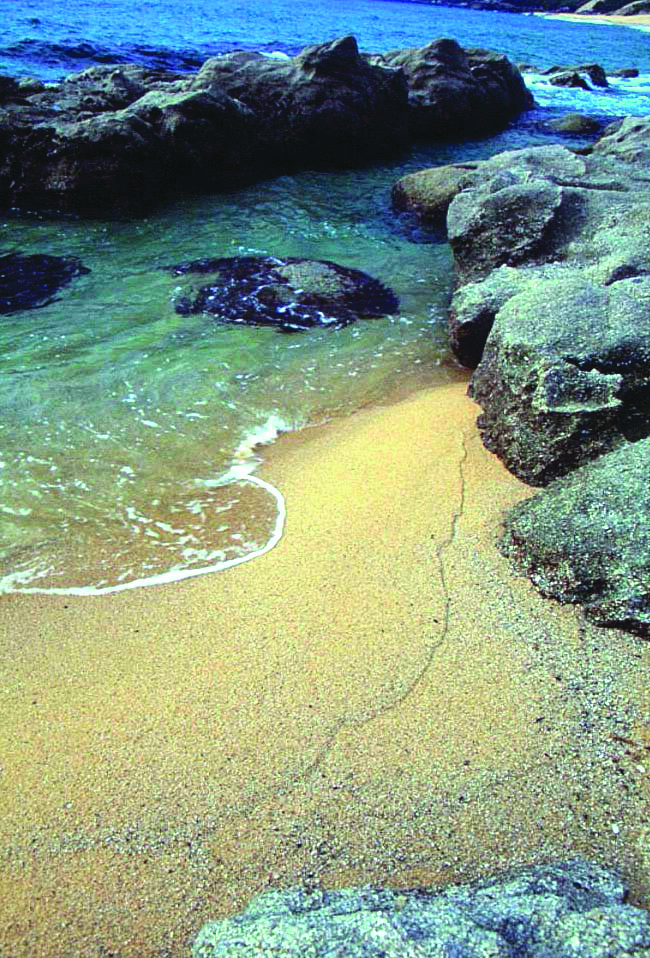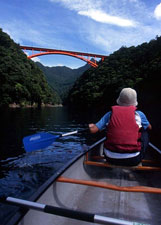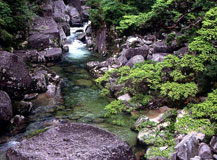It had been raining since the previous day, and I could feel the thick moisture spread through the air, falling through the crevices of tree branches that covered the sky above. My rain gear was completely wet with humidity and sweat—what a mess—yet my heart was like a sunny day filled with joy, soaking in the precipitous scenery. Yakushima is rain.
Our day started day from Miyanoura Campground. We arrived at Miyanoura Port by ferry via Kagoshima the day before, pitched a tent to save money and had dinner at a local café. Though Tokyo was still in its rainy season, it seemed like summer in Miyanoura; however, as we woke up that morning, the sky was already growing dark. We broke camp and waited for a bus headed to where we would start our three-day hike. Suddenly the rain began to fall and did not let up all day.
Although rain is not always pleasant, the rain in Yakushima is extraordinary. “Rain” is the symbol of this island. On my last visit when I gazed upon the island from the ferry, it looked like a rain cloud generator, with mounting clouds from sea level up to the sky.
Had it not been raining, I could never have experienced the mysterious silence and glory of the Yaku-sugi and Wilson Stump areas. I would have regretted missing the raindrops falling through the open crevice from above.
After the second day, it was still raining. With help from the wind, Mt. Miyanoura, the highest point in Kyushu, showed glimpses of its top among hovering clouds. On clear days you can usually see, through dense forest, the horizon of the ocean from the top. That day, 30 meters of visibility was all we got, but this is Yakushima after all, and there is always next time to experience the great view.
For the second night, we stayed for free at Yodogawa Hut near the entrance of the trail. We arrived just before dusk, and a middle-aged couple from Aomori was already there. They were very happy to be in Yakushima, as it had been their dream since they were young to go there.
Soon I realized I had made one big mistake during the hike. I had two, one-liter bottles in my backpack and didn’t realize one was broken, and all the water was gone! There was only a single bottle for the two of us—500 ml. each for an eight-hour trek. Luckily, spring water was everywhere and the water lost was easily replaced from the ground.

Inaka-hama Beach covered with rough grains of sand near Nagata. The ocean is so deep there that it is a good idea to stay on the rocky shore.

Red sea turtle eggs buried in the sand. In Nagata, volunteers take people on excursions to visit the hatching grounds.
Mr. Hidaka and a visit to ‘Water World’
“Where are you going? I can give you a ride, if you are heading to Abou.”
The next morning, while we were preparing to depart, a casually dressed man began talking to me. He said he comes to clean the bathroom at Yodogawa Hut every week and was about to leave for Abou, and his car was parked at the entrance of the trail.
“Well, our backpacks are heavy,” I said. We’ll walk to the bottom, but could you pick us up at Kigen-sugi?” I asked.
“Sure, no problem. See you soon,” he replied as he left.
Kigen-sugi was the name of Yaku-sugi more than 3,000 years ago, and we decided to get a ride from there to our next destination: Yakusugi Land. After that, we planned to go to the town of Abou by bus. The man was Mr. Hidaka, and we found out he was also the owner of a campground in Nagata where we were thinking about staying for a few days.
The next day, we departed for Nagata. This area is a famous red sea turtle breeding ground. We visited the sea turtle museum and headed for the campground where Mr. Hidaka awaited. There he was, smoothing with a roller, “You can pitch the tent anywhere you want. Here is a shower, and feel free to use the small truck over there.”
So, how about jumping into the cold water along the beach to cool off, I thought. The sea was crystal clear and a perfect temperature for swimming. It seemed the rain was finally over.
As our one-week stay at Abou was coming to a close, we decided to go to the secret riverside about which Mr. Hidaka had told us. There was a pool along the Nagata River and the water was absolutely stunning. Afterwards, we went back to Abou, pitched the tent and had dinner at a nearby pub—a common routine during our stay.
The last day before we returned, we rented a canoe along the Abou River after relaxing in a hot spring. Early the next morning, while we were enjoying another outdoor hot tub in Hirauchi, a man quickly came and joined us.
“Are you traveling? I came to this island two years ago. I loved this place so much I never left,” he exclaimed. And then he disappeared as quick as a wink.
During breakfast the same day, another man asked, “There is a hot spring here only known by the locals. Have you been there yet?” We soon found ourselves soaking in a bath hidden from tourists, talking to this man, Mr. Yamamoto, about many things, including the future of the area. Yakushima is a World Heritage site, and the locals are proud of the designation, which explains why many people I encountered seemed like tour guides. Visitors love this island so much, they always seem to come back.
While canoeing along the Abou River a thought occurred to me. Yakushima is a land of forest and water. The air absorbs the moisture from the ocean surrounding the island, pulling down rain over the mountains known as the “Forest of the Sea.” The water soaks into the moss-covered land, protecting trees such as the Jomon-sugi (said to be 5,000 years old) and finally flows into the river. The eco-system functions so well here and creates this island of forest and water.
After traveling to Miyanoura by bus, we checked into a Japanese inn and headed for a pub. The next day, on the ferry back, my mind wandered while staring at the island floating in the ocean, covered with thick dark clouds. “Oh, it’s raining again.”


(left) Floating down the Abo river in a Canadian canoe and gazing upon the river current up stream. (right)The Ara River runs through Yakusugi Land.




